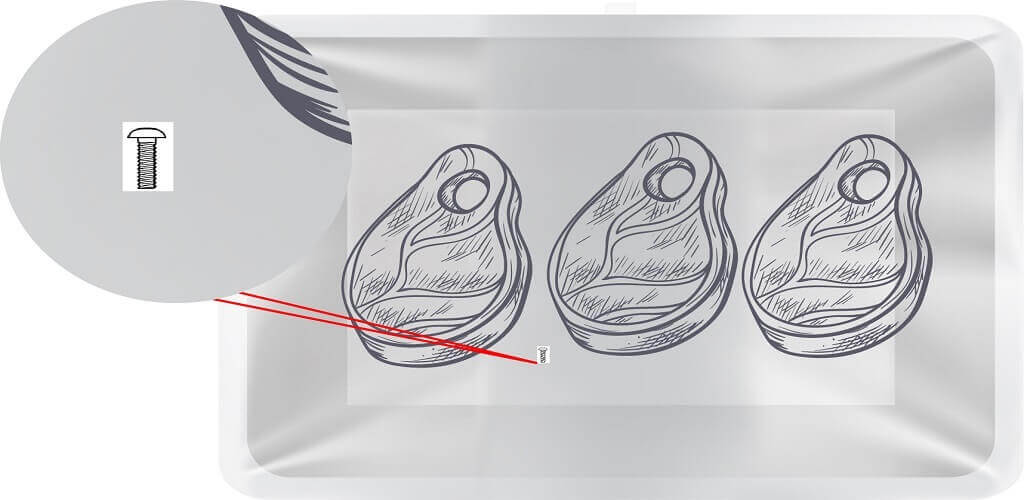What is Foreign Object Detection?

Key Takeaways
- Safety Critical: Foreign objects in products can cause serious health hazards and damage
- Business Impact: Contamination incidents lead to costly recalls and brand reputation damage
- Detection Technologies: Computer vision and infrared imaging enable automated detection
- Multiple Industries: Applications span food processing, manufacturing, aviation, and more
- Preventive Approach: Proactive detection systems reduce risk and ensure quality
Understanding Foreign Object Contamination
Foreign object detection is a critical quality control and safety process that identifies unwanted materials in products or environments where they don't belong. Any particle, substance, debris, or agent found in an inappropriate location is considered a foreign object, potentially causing harm to consumers, damaging equipment, or compromising product integrity.
 Advanced vision systems can detect even small foreign objects in food products
Advanced vision systems can detect even small foreign objects in food products
In the food industry alone, foreign body contamination represents one of the most significant drivers of consumer complaints and product recalls, making effective detection systems essential for both safety and business continuity.
What Constitutes a Foreign Object?
Foreign objects can take many forms depending on the industry and context:
In Food Processing
- Metal fragments: From machinery, tools, or equipment parts
- Plastic pieces: From packaging materials or production equipment
- Glass shards: From broken containers or light fixtures
- Personal items: Jewelry, hair nets, gloves, or other employee belongings
- Organic matter: Insects, stones, wood splinters, or plant materials
In Manufacturing and Aviation
- Tools and hardware: Screws, bolts, nuts, or maintenance equipment
- Building materials: Concrete chips, insulation, or wire fragments
- Personal items: Badges, pens, coins, or clothing items
- Natural elements: Rocks, sand, vegetation, or wildlife
- Paper products: Documents, labels, or packaging materials
The presence of these objects can lead to serious consequences, from consumer injuries and equipment damage to production shutdowns and costly recalls.
The Business Impact of Foreign Object Contamination
Foreign object incidents can have devastating effects on businesses:
- Product Recalls: In 2018, Wayne Farms recalled 439,000 pounds of ready-to-eat chicken after metal fragments were discovered
- Global Impact: Mars recalled chocolate products from 55 countries in 2016 when a consumer found plastic in a Snickers bar
- Financial Losses: Foreign object recalls can cost companies millions in direct expenses and lost sales
- Brand Damage: Consumer trust erodes quickly after contamination incidents
- Legal Consequences: Regulatory penalties and lawsuits often follow serious contamination cases
These high-profile examples demonstrate why companies invest heavily in detection technologies to prevent such occurrences.
How Foreign Object Detection Works
Modern detection systems employ several technologies to identify unwanted materials:
Computer Vision Systems
Advanced cameras and image processing algorithms can:
- Capture high-resolution images of products on production lines
- Analyze visual patterns to identify anomalies
- Detect color, shape, and texture differences that indicate contamination
- Process thousands of items per minute with consistent accuracy
Infrared and Thermal Imaging
Thermal detection systems offer unique advantages:
- Detect temperature differences between products and foreign objects
- Work effectively with frozen or refrigerated products
- Identify materials that might be visually similar but thermally distinct
- Operate in challenging lighting conditions
X-Ray and Metal Detection
Traditional detection methods remain valuable:
- X-ray systems can detect dense materials inside packaged products
- Metal detectors identify ferrous and non-ferrous metallic contaminants
- Combined systems provide redundancy for critical applications
- Specialized settings accommodate different product characteristics
The Detection Process in Action
In a typical food manufacturing environment, foreign object detection follows these steps:
- Continuous Monitoring: Products move along conveyor systems through detection zones
- Multi-Sensor Analysis: Items are scanned using various detection technologies
- Real-Time Processing: Advanced algorithms analyze sensor data instantly
- Contamination Identification: The system flags products containing potential foreign objects
- Automated Rejection: Contaminated items are automatically removed from the production line
- Documentation: The system records all detection events for quality control and reporting
- Continuous Improvement: Data analysis helps identify and address contamination sources
This automated approach ensures consistent inspection without the limitations of human visual inspection.
Implementation Challenges
Despite technological advances, foreign object detection presents several challenges:
- Product Variability: Natural products like food items have inherent variations
- Detection Sensitivity: Balancing detection accuracy against false positives
- Speed Requirements: Maintaining detection accuracy at high production speeds
- Material Limitations: Some contaminants have properties similar to the product itself
- Integration Complexity: Incorporating detection systems into existing production lines
Overcoming these challenges requires specialized expertise and customized solutions.
Conclusion
Foreign object detection represents a critical safety and quality control function across multiple industries. As detection technologies continue to advance, particularly in computer vision and artificial intelligence, manufacturers gain increasingly powerful tools to protect consumers and their brands from the consequences of contamination.
For food processors, manufacturers, and other industries where foreign object contamination poses risks, implementing robust detection systems is not merely a regulatory requirement but a business imperative. These technologies help ensure product integrity, maintain consumer trust, and prevent the substantial financial and reputational damage that can result from contamination incidents.
This article provides a historical perspective on foreign object detection. While Visionify now specializes in computer vision solutions for various industries, we recognize the continuing importance of visual inspection technologies in ensuring product safety and quality.
Want to learn more?
Discover how our Vision AI safety solutions can transform your workplace safety.
Schedule a DemoSchedule a Meeting
Book a personalized demo with our product specialists to see how our AI safety solutions can work for your business.
Choose a convenient time
Select from available slots in your timezone
30-minute consultation
Brief but comprehensive overview of our solutions
Meet our product experts
Get answers to your specific questions
Related Articles
Subscribe to our newsletter
Get the latest safety insights and updates delivered to your inbox.


